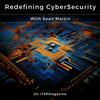589 episodes

The Hidden Risk Inside Your Build Pipeline: When Open Source Becomes an Attack Vector | A Conversation with Paul McCarty | Redefining CyberSecurity with Sean Martin
16/12/2025 | 40 mins.
⬥EPISODE NOTES⬥Modern application development depends on open source packages moving at extraordinary speed. Paul McCarty, Offensive Security Specialist focused on software supply chain threats, explains why that speed has quietly reshaped risk across development pipelines, developer laptops, and CI environments.JavaScript dominates modern software delivery, and the npm registry has become the largest package ecosystem in the world. Millions of packages, thousands of daily updates, and deeply nested dependency chainsഴ് often exceeding a thousand indirect dependencies per application. That scale creates opportunity, not only for innovation, but for adversaries who understand how developers actually build software.This conversation focuses on a shift that security leaders can no longer ignore. Malicious packages are not exploiting accidental coding errors. They are intentionally engineered to steal credentials, exfiltrate secrets, and compromise environments long before traditional security tools see anything wrong. Attacks increasingly begin on developer machines through social engineering and poisoned repositories, then propagate into CI pipelines where access density and sensitive credentials converge.Paul outlines why many existing security approaches fall short. Vulnerability databases were built for mistakes, not hostile code. AppSec teams are overloaded burning down backlogs. Security operations teams rarely receive meaningful telemetry from build systems. The result is a visibility gap where malicious code can run, disappear, and leave organizations unsure what was touched or stolen.The episode also explores why simple advice like “only use vetted packages” fails in practice. Open source ecosystems move too fast for manual approval models, and internal package repositories often collapse under friction. Meanwhile, attackers exploit maintainer accounts, typosquatting domains, and ecosystem trust to reach billions of downstream installations in a single event.This discussion challenges security leaders to rethink how software supply chain risk is defined, detected, and owned. The problem is no longer theoretical, and it no longer lives only in development teams. It sits at the intersection of intellectual property, identity, and delivery velocity, demanding attention from anyone responsible for protecting modern software-driven organizations.⬥GUEST⬥Paul McCarty, NPM Hacker and Software Supply Chain Researcher | On LinkedIn: https://www.linkedin.com/in/mccartypaul/⬥HOST⬥Sean Martin, Co-Founder at ITSPmagazine and Host of Redefining CyberSecurity Podcast | On LinkedIn: https://www.linkedin.com/in/imsmartin/ | Website: https://www.seanmartin.com⬥RESOURCES⬥LinkedIn Post: https://www.linkedin.com/posts/mccartypaul_i-want-to-introduce-you-to-my-latest-project-activity-7396297753196363776-1N-TOpen Source Malware Database: https://opensourcemalware.comOpenSSF Scorecard Project: https://securityscorecards.dev⬥ADDITIONAL INFORMATION⬥✨ More Redefining CyberSecurity Podcast: 🎧 https://www.seanmartin.com/redefining-cybersecurity-podcastRedefining CyberSecurity Podcast on YouTube:📺 https://www.youtube.com/playlist?list=PLnYu0psdcllS9aVGdiakVss9u7xgYDKYq📝 The Future of Cybersecurity Newsletter: https://www.linkedin.com/newsletters/7108625890296614912/Contact Sean Martin to request to be a guest on an episode of Redefining CyberSecurity: https://www.seanmartin.com/contact⬥KEYWORDS⬥paul mccarty, sean martin, software, supplychain, appsec, npm, javascript, ci, malware, opensource, redefining cybersecurity, cybersecurity podcast, redefining cybersecurity podcast Hosted by Simplecast, an AdsWizz company. See pcm.adswizz.com for information about our collection and use of personal data for advertising.

Rethinking Public Health Workflows Through Automation and Governance: Why Data Modernization May Be The Key | A Conversation with Jim St. Clair | Redefining CyberSecurity with Sean Martin
09/12/2025 | 44 mins.
⬥EPISODE NOTES⬥Artificial intelligence is reshaping how public health organizations manage data, interpret trends, and support decision-making. In this episode, Sean Martin talks with Jim St. Clair, Vice President of Public Health Systems at a major public health research institute, Altarum, about what AI adoption really looks like across federal, state, and local agencies.Public health continues to face pressure from shifting budgets, aging infrastructure, and growing expectations around timely reporting. Jim highlights how initiatives launched after the pandemic pushed agencies toward modernized systems, new interoperability standards, and a stronger foundation for automated reporting. Interoperability and data accessibility remain central themes, especially as agencies work to retire manual processes and unify fragmented registries, surveillance systems, and reporting pipelines.AI enters the picture as a multiplier rather than a replacement. Jim outlines practical use cases that public health agencies can act on now, from community health communication tools and emergency response coordination to predictive analytics for population health. These approaches support faster interpretation of data, targeted outreach to communities, and improved visibility into ongoing health activity.At the same time, CISOs and security leaders are navigating a new risk environment as agencies explore generative AI, open models, and multi-agent systems. Sean and Jim discuss the importance of applying disciplined data governance, aligning AI with FedRAMP and state-level controls, and ensuring that any model running inside an organization’s environment is treated with the same rigor as traditional systems.The conversation closes with a look at where AI is headed. Jim notes that multi-agent frameworks and smaller, purpose-built models will shape the next wave of public health technology. These systems introduce new opportunities for automation and decision support, but also require thoughtful implementation to ensure trust, reliability, and safety.This episode presents a realistic, forward-looking view of how AI can strengthen the future of public health and the cybersecurity responsibilities that follow.⬥GUEST⬥Jim St. Clair, Vice President, Public Health Systems, Altarum | On LinkedIn: https://www.linkedin.com/in/jimstclair/⬥HOST⬥Sean Martin, Co-Founder at ITSPmagazine and Host of Redefining CyberSecurity Podcast | On LinkedIn: https://www.linkedin.com/in/imsmartin/ | Website: https://www.seanmartin.com⬥RESOURCES⬥N/A⬥ADDITIONAL INFORMATION⬥✨ More Redefining CyberSecurity Podcast: 🎧 https://www.seanmartin.com/redefining-cybersecurity-podcastRedefining CyberSecurity Podcast on YouTube:📺 https://www.youtube.com/playlist?list=PLnYu0psdcllS9aVGdiakVss9u7xgYDKYq📝 The Future of Cybersecurity Newsletter: https://www.linkedin.com/newsletters/7108625890296614912/Contact Sean Martin to request to be a guest on an episode of Redefining CyberSecurity: https://www.seanmartin.com/contact⬥KEYWORDS⬥sean martin, jim st. clair, ai, interoperability, public health, data governance, population health, cybersecurity, ciso, automation, redefining cybersecurity, cybersecurity podcast, redefining cybersecurity podcast Hosted by Simplecast, an AdsWizz company. See pcm.adswizz.com for information about our collection and use of personal data for advertising.

AI, Quantum, and the Changing Role of Cybersecurity | ISC2 Security Congress 2025 Coverage with Jon France, Chief Information Security Officer at ISC2 | On Location with Sean Martin and Marco Ciappelli
03/12/2025 | 26 mins.
What Security Congress Reveals About the State of CybersecurityThis discussion focuses on what ISC2 Security Congress represents for practitioners, leaders, and organizations navigating constant technological change. Jon France, Chief Information Security Officer at ISC2, shares how the event brings together thousands of cybersecurity practitioners, certification holders, chapter leaders, and future professionals to exchange ideas on the issues shaping the field today. Themes That Stand OutAI remains a central point of attention. France notes that organizations are grappling not only with adoption but with the shift in speed it introduces. Sessions highlight how analysts are beginning to work alongside automated systems that sift through massive data sets and surface early indicators of compromise. Rather than replacing entry-level roles, AI changes how they operate and accelerates the decision-making path. Quantum computing receives a growing share of focus as well. Attendees hear about timelines, standards emerging from NIST, and what preparedness looks like as cryptographic models shift. Identity-based attacks and authorization failures also surface throughout the program. With machine-driven compromises becoming easier to scale, the community explores new defenses, stronger controls, and the practical realities of machine-to-machine trust. Operational technology, zero trust, and machine-speed threats create additional urgency around modernizing security operations centers and rethinking human-to-machine workflows. A Place for Every Stage of the CareerFrance describes Security Congress as a cross-section of the profession: entry-level newcomers, certification candidates, hands-on practitioners, and CISOs who attend for leadership development. Workshops explore communication, business alignment, and critical thinking skills that help professionals grow beyond technical execution and into more strategic responsibilities. Looking Ahead to the Next CongressThe next ISC2 Security Congress will be held in October in the Denver/Aurora area. France expects AI and quantum to remain key themes, along with contributions shaped by the call-for-papers process. What keeps the event relevant each year is the mix of education, networking, community stories, and real-world problem-solving that attendees bring with them.The ISC2 Security Congress 2025 is a hybrid event taking place from October 28 to 30, 2025 Coverage provided by ITSPmagazineGUEST:Jon France, Chief Information Security Officer at ISC2 | On LinkedIn: https://www.linkedin.com/in/jonfrance/HOST:Sean Martin, Co-Founder, ITSPmagazine and Studio C60 | Website: https://www.seanmartin.comFollow our ISC2 Security Congress coverage: https://www.itspmagazine.com/cybersecurity-technology-society-events/isc2-security-congress-2025Catch all of our event coverage: https://www.itspmagazine.com/technology-and-cybersecurity-conference-coverageISC2 Security Congress: https://www.isc2.orgNIST Post-Quantum Cryptography Standards: https://csrc.nist.gov/projects/post-quantum-cryptographyISC2 Chapters: https://www.isc2.org/chaptersWant to share an Event Briefing as part of our event coverage? Learn More 👉 https://itspm.ag/evtcovbrfWant Sean and Marco to be part of your event or conference? Let Us Know 👉 https://www.studioc60.com/performance#ideasKEYWORDS: cybersecurity, ai security, isc2 congress, quantum computing, identity attacks, zero trust, soc automation, cyber jobs, cyber careers, cyber leadership, security operations, threat intelligence, machine speed, authentication, authorization, sean martin, jon france, identity, soc, certification, leadership, event coverage, on location, conference Hosted by Simplecast, an AdsWizz company. See pcm.adswizz.com for information about our collection and use of personal data for advertising.

A Practical Look at Incident Handling: How a Sunday Night Bug Bounty Email Triggered a Full Investigation | A Screenly Brand Spotlight Conversation with Co-founder of Screenly, Viktor Petersson
25/11/2025 | 17 mins.
This episode focuses on a security incident that prompts an honest discussion about transparency, preparedness, and the importance of strong processes. Sean Martin speaks with Viktor Petersson, Founder and CEO of Screenly, who shares how his team approaches digital signage security and how a recent alert from their bug bounty program helped validate the strength of their culture and workflows.Screenly provides a secure digital signage platform used by organizations that care deeply about device integrity, uptime, and lifecycle management. Healthcare facilities, financial services, and even NASA rely on these displays, which makes the security posture supporting them a priority. Viktor outlines why security functions best when embedded into culture rather than treated as a compliance checkbox. His team actively invests in continuous testing, including a structured bug bounty program that generates a steady flow of findings.The conversation centers on a real event: a report claiming that more than a thousand user accounts appeared in a public leak repository. Instead of assuming the worst or dismissing the claim, the team mobilized within hours. They validated the dataset, built correlation tooling, analyzed how many records were legitimate, and immediately reset affected accounts. Once they ruled out a breach of their systems, they traced the issue to compromised end user devices associated with previously known credential harvesting incidents.This scenario demonstrates how a strong internal process helps guide the team through verification, containment, and communication. Viktor emphasizes that optional security features only work when customers use them, which is why Screenly is moving to passwordless authentication using magic links. Removing passwords eliminates the attack vector entirely, improving security for customers without adding friction.For listeners, this episode offers a clear look at what rapid response discipline looks like, how bug bounty reports can add meaningful value, and why passwordless authentication is becoming a practical way forward for SaaS platforms. It is a timely reminder that transparency builds trust, and security culture determines how confidently a team can navigate unexpected events.Learn more about Screenly: https://itspm.ag/screenly1oNote: This story contains promotional content. Learn more.GUESTViktor Petersson, Co-founder of Screenly | On LinkedIn: https://www.linkedin.com/in/vpetersson/RESOURCESLearn more and catch more stories from Screenly: https://www.itspmagazine.com/directory/screenlyLinkedIn Post: https://www.linkedin.com/posts/vpetersson_screenly-security-incident-response-how-activity-7393741638918971392-otkkBlog: Security Incident Response: How We Investigated a Data Leak and What We're Doing Next: https://www.screenly.io/blog/2025/11/10/security-incident-response-magic-links/Are you interested in telling your story?▶︎ Full Length Brand Story: https://www.studioc60.com/content-creation#full▶︎ Spotlight Brand Story: https://www.studioc60.com/content-creation#spotlightKeywords: sean martin, marco ciappelli, viktor petersson, security, authentication, bugbounty, signage, incidentresponse, breaches, cybersecurity, brand story, brand marketing, marketing podcast, brand story podcast, brand spotlight Hosted by Simplecast, an AdsWizz company. See pcm.adswizz.com for information about our collection and use of personal data for advertising.

Inside the Economics That Shape Modern Cybersecurity Innovations: How the Cybersecurity Startup Engine Really Works | A Conversation with Investor and Author, Ross Haleliuk | Redefining CyberSecurity with Sean Martin
25/11/2025 | 47 mins.
⬥EPISODE NOTES⬥Understanding the Startup Engine Behind CybersecurityThis episode brings Sean Martin together with Ross Haleliuk, author, investor, product leader, and creator of Venture Insecurity, for a candid look at the forces shaping cybersecurity startups today. Ross shares how his decade of product leadership and long involvement in the security community give him a unique perspective on what drives founders, what creates market gaps, and why new companies keep entering a space already full of tools.Why Security Produces So Many ProductsRoss explains that the large number of security tools is not evidence of an industry losing control. Instead, it reflects a technology ecosystem where entrepreneurship has become easier and where attackers, not practitioners, define what defenders need. Because threats shift constantly, security leaders must always look for clues on what could fail next. That constant uncertainty fuels innovation.What Motivates FoundersDespite outside assumptions, Ross observes that most founders are motivated by the problems they have lived themselves. Some come from enterprise teams. Others come from military backgrounds. Many find traction with early open source work. Few come into cybersecurity to chase quick wins, and most do not survive long enough to chase profits even if they wanted to.Security as Business EnablementSean and Ross discuss the role of security as a business driver. In regulated sectors, companies invest because they must. In technology companies, strong security is a sales enabler that gives customers confidence to use their products. Outside of tech, the priority is more about resilience and operational continuity.How Buyers Should Think About StartupsRoss outlines the tradeoffs. Startups deliver speed, responsiveness, fresh architecture, and modern user experience. Large vendors provide stability, predictability, and broad coverage. Neither is perfect. Security leaders should decide based on the importance of the capability, the level of influence they want, and the outcomes they need.This conversation highlights the practical realities behind the security products organizations choose and the people who build them. Listeners will hear both the optimism and the honesty that define today’s cybersecurity innovation economy.⬥GUEST⬥Ross Haleliuk, Security product leader, author, advisor, board member and investor | On LinkedIn: https://www.linkedin.com/in/rosshaleliuk/⬥HOST⬥Sean Martin, Co-Founder at ITSPmagazine and Host of Redefining CyberSecurity Podcast | On LinkedIn: https://www.linkedin.com/in/imsmartin/ | Website: https://www.seanmartin.com⬥RESOURCES⬥Inspiring Blog: https://ventureinsecurity.net/p/not-every-security-leader-works-at⬥ADDITIONAL INFORMATION⬥✨ More Redefining CyberSecurity Podcast: 🎧 https://www.seanmartin.com/redefining-cybersecurity-podcastRedefining CyberSecurity Podcast on YouTube:📺 https://www.youtube.com/playlist?list=PLnYu0psdcllS9aVGdiakVss9u7xgYDKYq📝 The Future of Cybersecurity Newsletter: https://www.linkedin.com/newsletters/7108625890296614912/Contact Sean Martin to request to be a guest on an episode of Redefining CyberSecurity: https://www.seanmartin.com/contact⬥KEYWORDS⬥sean martin, ross haleliuk, cybersecurity, startups, venture security, founders, innovation, risk, resilience, product strategy, redefining cybersecurity, cybersecurity podcast, redefining cybersecurity podcast Hosted by Simplecast, an AdsWizz company. See pcm.adswizz.com for information about our collection and use of personal data for advertising.
More Business podcasts
Trending Business podcasts
About Redefining CyberSecurity
Listen to Redefining CyberSecurity, FEAR & GREED | Business News and many other podcasts from around the world with the radio.net app

Get the free radio.net app
- Stations and podcasts to bookmark
- Stream via Wi-Fi or Bluetooth
- Supports Carplay & Android Auto
- Many other app features
Get the free radio.net app
- Stations and podcasts to bookmark
- Stream via Wi-Fi or Bluetooth
- Supports Carplay & Android Auto
- Many other app features


Redefining CyberSecurity
download the app,
start listening.
























